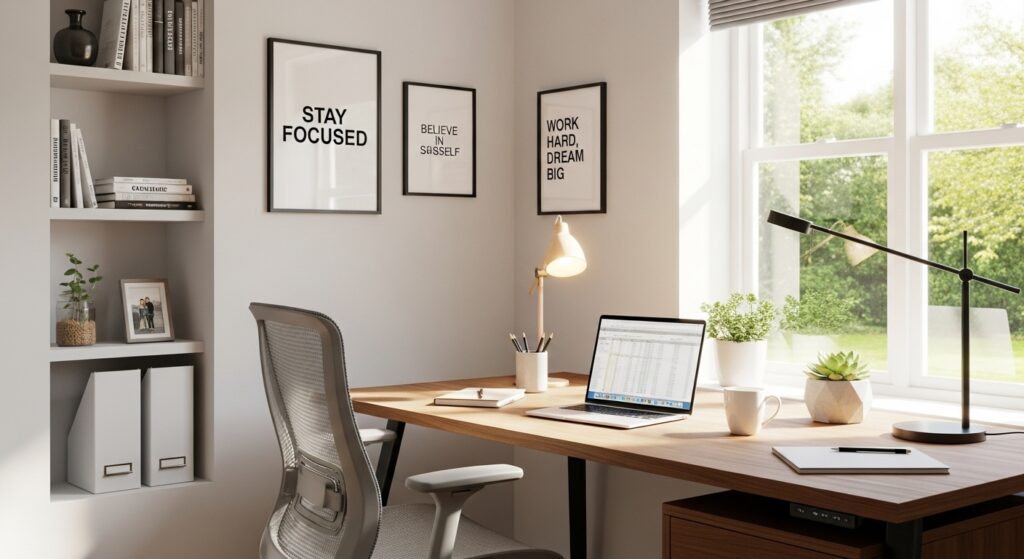Your workspace plays a major role in your productivity, creativity, and overall mood. An organized and inspiring environment can help you focus, reduce stress, and stay motivated throughout the day. On the other hand, a cluttered and uninspiring setup can make even the simplest tasks feel overwhelming.
In this guide, you’ll learn how to create a workspace that not only supports your goals but also sparks your creativity and keeps you motivated.
Why Your Workspace Matters
Your environment shapes your mindset. When your workspace is clean and inspiring, your brain associates it with focus and productivity. A disorganized area sends the opposite message, triggering stress and procrastination.
The way your workspace looks and feels can influence:
- Your energy levels
- Your concentration
- Your creativity
- Your motivation to work
By intentionally designing your workspace, you set yourself up for consistent success.
Step 1: Declutter and Simplify
The first step to creating an inspiring workspace is removing what you don’t need. Clutter creates visual noise, making it harder for your brain to focus.
Tips for decluttering:
- Remove unnecessary papers, cables, and old gadgets.
- Keep only the tools and items you use daily within reach.
- Store infrequently used items in drawers or storage boxes.
Rule to follow: If you haven’t used it in a month, it probably doesn’t need to be on your desk.
Step 2: Invest in Comfort
You’ll likely spend hours in your workspace, so comfort is essential. An uncomfortable chair or poor lighting can cause fatigue and physical discomfort, which lowers productivity.
Essentials to consider:
- An ergonomic chair that supports your back.
- A desk at the right height for your posture.
- Adjustable lighting to prevent eye strain.
Step 3: Add Inspiration
Your workspace should make you feel good every time you sit down. Add personal touches that inspire you without creating distractions.
Ideas for inspiration:
- Motivational quotes or affirmations on the wall.
- A small plant for a touch of nature.
- Artwork that sparks creativity.
The key is balance — too many decorative items can create clutter.
Step 4: Organize for Efficiency
The layout of your workspace should make it easy to find what you need quickly. Group similar items together and create dedicated zones for different tasks.
Example:
- Computer and notepad in your main work zone.
- Storage drawers for office supplies.
- A shelf for books and reference materials.
Using organizers, trays, and cable management solutions keeps everything tidy.
Step 5: Optimize Lighting
Lighting affects both your mood and focus. Natural light is ideal, so position your desk near a window if possible. If not, invest in warm, adjustable desk lighting to create a comfortable atmosphere.
Tip: Avoid harsh overhead lights that cause glare on your screen.
Step 6: Minimize Digital Clutter
An organized workspace also means keeping your digital space clean. A messy desktop with dozens of files can be just as distracting as a cluttered desk.
How to declutter digitally:
- Create folders for different projects.
- Delete unused apps.
- Use a clean wallpaper for a minimal look.
Step 7: Keep Essentials Within Reach
To avoid constant interruptions, make sure the tools you use most often are within arm’s reach. This prevents unnecessary breaks that can disrupt your workflow.
Step 8: Maintain Your Workspace Daily
The easiest way to keep your workspace organized is to tidy it up at the end of each day. Spending five minutes putting things back in place ensures you start the next day with a fresh environment.
Key Takeaways
- A clean and inspiring workspace boosts productivity and creativity.
- Comfort, good lighting, and organization are essential.
- Personal touches should inspire without cluttering.
- Maintaining your workspace daily prevents buildup of distractions.
Your workspace is more than just a desk — it’s a reflection of your mindset. By creating an environment that energizes and motivates you, you make it easier to stay focused and inspired every day.












